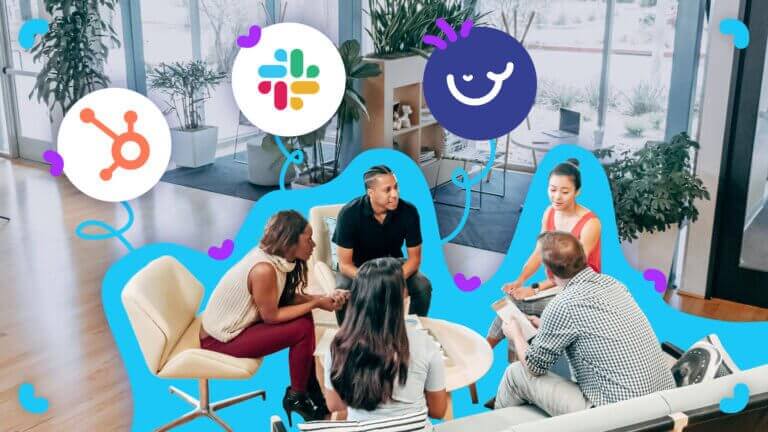The People, Process, Technology (PPT) framework is a holistic approach to growth and to overcoming common growth challenges.
This model suggests that for a company to operate smoothly and innovate, it must balance three key components: people (the skills and talents of the team), processes (the workflows and procedures that guide actions), and technology (the tools that support tasks). By aligning these three, businesses can achieve their goals more efficiently and effectively.
But what makes this alignment so crucial? Think of it like a three-legged stool: if one leg is weak or out of sync, the whole structure wobbles.
Today, we’ll explore how this people, process, technology framework helps organizations get aligned and reach new heights.
What is the People, process, and Technology (PPT) framework?
The People, Process, Technology framework has its roots in the 1960s, when business theorist Harold Leavitt introduced his “Diamond Model,” which illustrated how the different parts of an organization influence each other. His idea evolved into a simpler "golden triangle," where people, processes, and technology each support the whole.
- People: The workforce, their skills, culture, and capabilities
- Process: The workflows, procedures, and methodologies
- Technology: The tools, systems, and platforms that enable work
Think of it as a three-legged stool – each component must be equally strong and well-balanced for the organization to function effectively. When one element is weak or out of alignment, the entire system becomes unstable.
So, how does this apply to businesses today? Most leaders know change impacts all areas of a company—not just one department. By focusing on people, process, and technology together, organizations can navigate change in a way that improves performance, encourages collaboration, and ultimately fuels growth.
Let’s dive deeper into each element of the PPT framework.

Elements of the People, Process, Technology (PPT) Framework
1. People: The Core of the PPT Framework
People are the driving force behind any organization. This pillar focuses on the skills, experiences, and culture within the team. Even the most sophisticated processes and technologies can’t succeed without skilled, motivated people.
🎯 The goal here is to get the right people in the right seats
Best Practices for People:
- Hire and Retain Talent: Use tools like the EOS® People Analyzer™ to ensure each team member is in the right seat. Invest in hiring, onboarding, and training processes that align with your organizational goals.
- Foster a Change-Ready Culture: Encourage continuous learning and adaptability so your team can embrace new technologies and processes as they evolve.
- Engage and Empower Employees: Create a positive work environment that supports team members’ growth and aligns their roles with company objectives.
Example: A SaaS company aiming for fast customer onboarding might focus on hiring tech-savvy customer success reps and empowering them with ongoing training in communication skills and industry best practices.
2. Process: The Glue Holding It Together
Process refers to the workflows, routines, and standards that guide day-to-day activities. Well-defined processes reduce inefficiencies, streamline communication, and ensure consistency, even when teams are scaling or adapting to new changes.
🎯 The goal here is to identify what works and keep improving in that!
Best Practices for Process:
- Document and Review Core Processes: Tools like Whale can help create accessible process documentation for onboarding and team training.
- Adapt and Optimize Workflows: Regularly review processes to remove bottlenecks and ensure workflows remain effective as your team and technology evolve.
- Focus on Communication: Make sure processes are clear and understandable to prevent miscommunication. Keep feedback loops open for improvements.
Think of an F1 pit crew: Even with the best car (technology) and driver (people), without an optimized pit stop process, time is lost, impacting the entire race. In business, well-oiled processes are equally crucial for efficiency and speed.
3. Technology: The Power that Drives Change
Technology within the PPT framework includes the tools, systems, and platforms that support your people and processes. This includes everything from productivity software to data analytics platforms. But remember, technology alone doesn’t solve problems—it’s most effective when paired with the right people and processes.
🎯 The goal here is to identify what tools are needed that will help you unlock growth in the business.
Best Practices for Technology:
- Choose Tools that Fit Your Needs: Invest in technology that aligns with your workflows and team’s skills. For instance, a CRM platform for customer management or an analytics tool to gain insights on customer trends. We recommend using a proper procurement process so that the tech delivers the ROI it needs to.
- Support Adoption: Use digital adoption platforms like Whatfix to guide your team in using new tools effectively. These platforms offer in-app guidance, minimizing the learning curve.
- Evaluate and Update Regularly: Make sure your technology remains relevant as business needs evolve. Periodic evaluations help ensure each tool still aligns with organizational goals.
Example: A HealthTech company using advanced analytics and marketing automation tools to analyze customer data, build effective marketing campaigns, and reach its target audience. Here, technology supports both processes and the marketing team.
How to Interlink People, Process, and Technology 🏎️
The idea of interlinking people, process, and technology might sound like something that only large enterprises need to worry about. But whether you’re a startup, a small business, or a global corporation, these three elements are always working together—and their alignment can be the difference between success and failure.
Let’s use a metaphor from Formula 1🏎️ racing to make this clear.
In F1, speed and precision are everything. You could have the best driver (people), but without an efficient pit crew routine (process) and a high-performance car (technology), winning is unlikely.
Here’s how the same interlinking applies to businesses:
- People are your drivers, bringing skill, experience, and innovation.
- Process is the pit crew routine, ensuring each step is executed with precision to save time and increase efficiency.
- Technology is the car itself, providing the power to make things happen faster and with greater impact.
When these elements work together, you have a team that performs like a finely tuned F1 car—each part enhancing the other. But if one part is out of sync, the whole system suffers. Interlinking people, process, and technology is about ensuring each area complements and strengthens the others, creating a powerful, agile organization ready to tackle challenges and seize opportunities.

How to use the people process technology framework to get aligned
So, how exactly do you use the People, Process, Technology framework to bring your organization into alignment? It starts with understanding how each piece supports the others. The PPT framework doesn’t just focus on one area at a time; it’s a way to view your organization as a connected whole.
Here’s a simple approach to get started:
Assess Your Current State
Look at each pillar (people, process, and technology) individually. Are there gaps in skills, outdated processes, or tools that no longer serve their purpose? Identify the strengths and weaknesses in each area.
Set Clear Goals Across All Three Areas
Define what success looks like for each pillar. Do you need more efficient processes? More skilled team members? Updated technology? Setting specific, measurable goals for each area ensures you’re moving in the same direction.
Create a Cross-Functional Team for Implementation
Successful alignment isn’t achieved in silos. Bring together team members from different departments to work on changes across people, process, and technology. Cross-functional collaboration helps ensure every part of your organization understands and supports the plan.
Monitor and Adapt
Once the framework is in place, keep checking on progress. Alignment isn’t a one-time achievement—it’s an ongoing process. Regularly revisit each area, assess new needs, and adapt as necessary.
By following these steps, you can use the PPT framework to foster a culture of alignment, where every team member, process, and tool is working toward the same organizational goals.
Benefits of the People, Process, Technology Framework
Using the PPT framework provides numerous benefits, helping businesses stay competitive and efficient. Here’s how it can transform your organization:
- Enhanced Operational Efficiency: With aligned processes, people, and technology, teams work more efficiently, reducing redundancies and enhancing productivity.
- Improved Collaboration and Communication: Clear, documented processes foster open communication, breaking down silos and supporting cross-functional teamwork.
- Scalability and Adaptability: The framework’s flexibility allows organizations to scale effectively, adapting processes and tools as business needs change.
- Better Decision-Making: Data-driven insights from aligned technology empower informed decisions, enabling leaders to address challenges proactively.
Use cases for the people, process, and technology framework
The PPT framework can be particularly relevant for small and medium-sized enterprises (SMEs) or scaling businesses as they navigate growth challenges, enhance operational efficiency, and strive for competitive advantage.
Here are 2 use cases for the PPT framework in this context:
Using PPT for Digital Transformation
- People: Train your team to use new digital tools and encourage a culture of learning.
- Process: Streamline operations to improve efficiency.
- Technology: Adopt new systems (like CRM or onboarding software) to support your growth.
How to Enhance Customer Support
- People: Assess the skill level and training of your customer service team. Are they adequately trained
- Process: Review the current customer service processes. Streamlining these processes can significantly improve customer satisfaction.
- Technology: Implement or upgrade to a customer relationship management (CRM) system that can automate queries, making it easier for your team to respond quickly and effectively.
High Employee Turnover
- People: Evaluate your onboarding and career development programs. Are managers equipped to support and develop their teams?
- Process: Review your recruitment, retention, and promotion processes. Creating clear career paths and regular feedback loops can dramatically improve retention.
- Technology: Deploy HR analytics tools to identify turnover patterns and implement performance management software to facilitate regular check-ins and goal tracking.
Slow Sales Cycle
- People: Assess your sales team’s product knowledge and negotiation skills. Is additional training needed on objection handling?
- Process: Analyze your current sales pipeline stages and qualification criteria. Streamlining the qualification process can significantly reduce time-to-close.
- Technology: Implement or optimize your sales CRM with automated lead scoring and follow-up reminders to help reps focus on the most promising opportunities.
Poor Project Delivery
- People: Review project manager capabilities and team collaboration skills. Are roles and responsibilities clearly defined?
- Process: Examine your project planning and tracking methodology. Implementing agile practices can improve delivery speed and quality.
- Technology: Deploy project management software with automated task dependencies and resource allocation to keep projects on track.
Bottom Line? The PPT Framework is a Growth Model
The People, Process, Technology framework is more than just a model—it’s a roadmap for achieving operational alignment and growth.
When organizations commit to aligning these three elements, they create a resilient foundation that allows for adaptability, innovation, and ongoing success in a rapidly changing business landscape.
FAQs about people, process & technology (PPT)
What is the People, Process Technology (PPT) Framework??
The People, Process, Technology (PPT) Framework addresses the interconnection between people, processes, and technology.
At it’s core it’s a model for operating efficiency that aligns all key elements of the organization.
How does the PPT framework support change management?
By integrating technology and processes with people’s skills, the framework helps businesses adapt smoothly to new changes.
What Are Some Best Practices to Implement PPT Framework
Best practices for implementing the PPT Framework include;
- Optimize Current Technology (No one loves app sprawl)
- Ensure collaborative working across the areas of the business.
- Involve people in decision making.
- Think About Culture
- When approaching problems seek integrated solutions across all the elements
What are examples of PPT in practice?
Here some examples of when you would use PPT to diagnose and solve a business challenge.
For example;
- Employees are taking too long to complete routine tasks.
- Your employees are not using the most efficient workflows.
- You aren’t utilizing automated workflows where possible.
- You aren’t innovating or aren’t achieving competitive advantage.
Key Terms & Further Reading on people, process & technology (PPT)
Key Definitions
Knowledge management process definition
Change management definition
Internal communication tools definition
Additional resources
Operations templates
Construction management template
People directory template



